Kelvingrove - update July, 2005
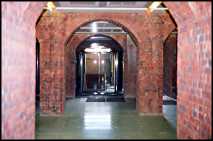 Refurbishment at Kelvingrove is progressing in a very impressive manner. Jim and I had been looking forward to seeing round the Art Gallery and Museum once more and last Thursday, 21st July, we went along to meet Alan Horn, Director of the Kelvingrove Refurbishment Appeal, so that he could take us on a tour of the building..
Refurbishment at Kelvingrove is progressing in a very impressive manner. Jim and I had been looking forward to seeing round the Art Gallery and Museum once more and last Thursday, 21st July, we went along to meet Alan Horn, Director of the Kelvingrove Refurbishment Appeal, so that he could take us on a tour of the building..
We entered from the new ground floor entrance situated under the statue of Saint Mungo on the side of the building facing the River Kelvin and the University of Glasgow. Space has been reclaimed from the car park to create a forecourt area and you also notice the new glass canopy which covers the fine dining restaurant. However, overall the building appears reassuringly unchanged and familiar.
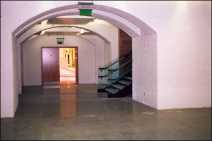 Kelvingrove has been recorded as being the most visited art gallery and museum in the UK outside London, however, it is anticipated that when it reopens in Summer 2006 the number of visitors will increase dramatically. The nearby parking facility being built in Bunhouse Road, just across the road at the Transport Museum, wil be very welcome.
Kelvingrove has been recorded as being the most visited art gallery and museum in the UK outside London, however, it is anticipated that when it reopens in Summer 2006 the number of visitors will increase dramatically. The nearby parking facility being built in Bunhouse Road, just across the road at the Transport Museum, wil be very welcome.
The ground floor entrance takes you into an area newly opened to the public and the former storage and office space has been transformed to include an Orientation Space, from where you can quickly find your way into the Central Hall The area is very attractive with lots of archways - interestingly these were part of the architect's original design but had been enclosed to create storage space. There are lots of examples of how the refurbishment has entailed 'taking away non-original features'.
It is marvellous to see the cafe and restaurant located in the bright area with wonderful views over the River Kelvin and up to the Univesity towers. This was originally designated as the Sculpture School for Glasgow's School of Art. Painstakingly, parts of the wall surrounding the Gallery have been removed and the glass canopy, as planned by the Victorians, erected. It is very easy to imagine enjoying a fine meal and some wine whilst gazing out from Kelvingrove.
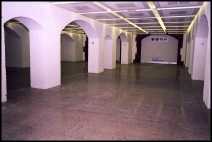 Also on the ground floor, important plans for the gallery have come to fruition with the creation of the new exhibition space. This simple and attractive area with plain white walls will allow Glasgow to play host to some of the world's most important exhibitions. Alan Horn is clearly excited about this prospect as is Lord MacFarlane, Chairman of the Refurbishment Appeal, who still remembers queuing along Sauchiehall Street to gain entry to the 1948 Van Gogh Exhibition. Alan also tells us that people still talk about when the Queen's Wedding Dress was shown at Kelvingrove in 1953.
Also on the ground floor, important plans for the gallery have come to fruition with the creation of the new exhibition space. This simple and attractive area with plain white walls will allow Glasgow to play host to some of the world's most important exhibitions. Alan Horn is clearly excited about this prospect as is Lord MacFarlane, Chairman of the Refurbishment Appeal, who still remembers queuing along Sauchiehall Street to gain entry to the 1948 Van Gogh Exhibition. Alan also tells us that people still talk about when the Queen's Wedding Dress was shown at Kelvingrove in 1953.
Once again Glasgow will be able to attract major exhibitions as the refurbishment programme has created an area which offers the essential flexibility, humidity control, lighting and security. Future plans will include one 'blockbuster' per year and a major exhibition (which remains cloaked in secrecy) is already planned for late 2006. There will also be a series of minor exhibitions attracting a wider and larger audience to Kelvingrove and as Alan points out: "For a period Kelvingrove will become the most state of the art museum in the world.. People will come not only to see the exhibitions but to see the museum itself.
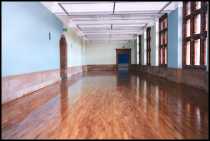 Other improvements will include more shopping areas (3 in all), the cafe in the ground floor, which can cater for 150 and the well situated 100 seater fine dining restaurant. There is also a modern lecture theatre which links to the cafe and which could be used by external organisatins for presentations and seminars. This ground floor area offers completely new facilities and the elegant stairways to the first floor bring you into the Kelvingrove we all know and love so well.
Other improvements will include more shopping areas (3 in all), the cafe in the ground floor, which can cater for 150 and the well situated 100 seater fine dining restaurant. There is also a modern lecture theatre which links to the cafe and which could be used by external organisatins for presentations and seminars. This ground floor area offers completely new facilities and the elegant stairways to the first floor bring you into the Kelvingrove we all know and love so well.
When you enter the central hall, you see features that you did not notice before. My first remark related to how beautiful the ceiling looked and Alan pointed out that others have had a similar response - and have 'admired the work undertaken on the ceiling'. However, no work has been carried out here - the difference is that you can now see it clearly because the windows are clean and decades of grime have been removed from the walls so that they now reflect the light. The wonderful lamps, the stained glass windows and the organ all stand out and many ornamental details observed as for the first time. All dingyness and tiredness have disappeared, some floors have new beech wood panels with reclaimed sections being used in other rooms and 25,000 cracked floor tiles have been replaced, Colour schemes have been chosen carefully to reflect the theme of each room and display cases have been selected on the basis of both design and robustness. The building has been spruced up in an extraordinary manner and with a firm affection.
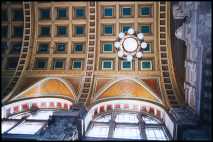 All 'icononic objects', such as Sir Roger the elephant, will remain on display and the familiar collections such as the Dutch Old Masters and French Impressionists will all be on view as before. Included in the plans is an area which will display the work of the Glasgow Boys and the Colourists and great excitement has heralded the return of Dali's 'Christ of Saint John on the Cross'. There will be some new and unusual works on display, they include 'La Faruk Madonna' painted by an Italian prisoner of war in Ethiopa during WW2; created on meal sacks it will be shown in the setting of a small chapel. The story behind the painting, which was presented to the commanding officer at the end of the second world war, should capture the interest of many visitors. Another imaginative display will be a Spitfire plane and this exhibit will be complemented by the stories of pilots from the City of Glasgow Volunteer Squadron who fought during WW2.
All 'icononic objects', such as Sir Roger the elephant, will remain on display and the familiar collections such as the Dutch Old Masters and French Impressionists will all be on view as before. Included in the plans is an area which will display the work of the Glasgow Boys and the Colourists and great excitement has heralded the return of Dali's 'Christ of Saint John on the Cross'. There will be some new and unusual works on display, they include 'La Faruk Madonna' painted by an Italian prisoner of war in Ethiopa during WW2; created on meal sacks it will be shown in the setting of a small chapel. The story behind the painting, which was presented to the commanding officer at the end of the second world war, should capture the interest of many visitors. Another imaginative display will be a Spitfire plane and this exhibit will be complemented by the stories of pilots from the City of Glasgow Volunteer Squadron who fought during WW2.
At the 'new' Kelvingrove there will be an opportunity to display 50% more of the 200,000 objects owned with 22 themed exhibition areas. Some displays will be changed regularly but activity will not be behind the scenes as 'visitors like to see what is going on', and unobtrusive grids will be used as an alternative to screening off areas. Exhibitions will show some of the most interesting items owned by Kelvingrove and reflect Glasgow's concern with cultural and social change and appreciation of both serious and more humourous topics. Exhibitions will include: 'Glasgow's Last Pearl Fisherman', 'Glasgow and the Wild West' (including a rhinestone shirt owned by Sydney Devine), 'James Watt's Steam Engine', 'South Asian Culture', 'Mental Health' and 'Violence Against Women'. An encyclopaedic museum, it will cover 'all aspects of the human experience'. Full details of the proposed galleries can be found on the Glasgow Museum's Website
The Museum will be divided into two wings Expressive Arts and People. Popular themes will include 'Scottish Battles' 'Creatures of the Past' and 'Scottish Wildlife' and there will be a permanent display in a room dedicated to Ancient Egypt. This has been made possible through Dr Neil MacGregor, Director of the British Museum, who visited Kelvingrove often when he lived in Glasgow as a boy and considers it to be 'one of the most significant art museums in Europe'. This gallery will also, of course, include Kelvingrove's four and a half ton sarcophagus, too heavy to be moved during the refurbishment programme.
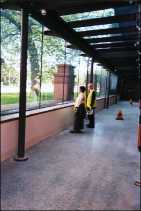 The Art Gallery and Museum will place an increased emphasis on education, which will benefit people of different learning abilities including serious scholars, school pupils and interested individuals. It will have three areas dedicated to 'hands- on learning' and a study centre where you can find out in more detail about any item in the gallery and museum. Fine Arts Curators will also be available at Nitshill Regional Centre and requests to see any object in storage will have a response period of 2 - 3 days; previously this involved a wait of 2 - 3 weeks. This will be a wonderful facility for visitors to Glasgow whose time in the City may be limited.
The Art Gallery and Museum will place an increased emphasis on education, which will benefit people of different learning abilities including serious scholars, school pupils and interested individuals. It will have three areas dedicated to 'hands- on learning' and a study centre where you can find out in more detail about any item in the gallery and museum. Fine Arts Curators will also be available at Nitshill Regional Centre and requests to see any object in storage will have a response period of 2 - 3 days; previously this involved a wait of 2 - 3 weeks. This will be a wonderful facility for visitors to Glasgow whose time in the City may be limited.
Plans at Kelvingrove are moving forward in a satisfactory manner - within budget and on time. The building is shaping up very impressively. Alan is a marvellous guide; his enthusiasm is boundless and his knowledge all-embracing. He explains not only how changes have been made but why. He understands that Kelvingrove is not just like other museums, whereas the Smithsonian and the Louvre may arouse feelings of awe and admiration, 'Kelvingrove inspires affection' and like nowhere else 'it pulls at the heart strings'. He explains how many people have regaled him with their first memories of Kelvingrove and spoken of its importance to them. This could explain the amazing response to the public element of the appeal which was launched three weeks ago, which has already resulted in 700 new donations. There will be a special Kelvingrove Donor Wall, which will pemanently record donors, these can also be in the form of In Memoriams.
Find out about making donations
Or telephone: Kelvingrove Refurbishment Appeal: 0141 565 4135
This was probably the last chance to see the Art Gallery and Museum before the displays start to be put in place. Our next visit will be when Kelvingrove reopens in Summer, 2006.
Pat Byrne, July, 2005
Further information about Kelvingrove plus earlier updates.
Photos by Jim Byrne







